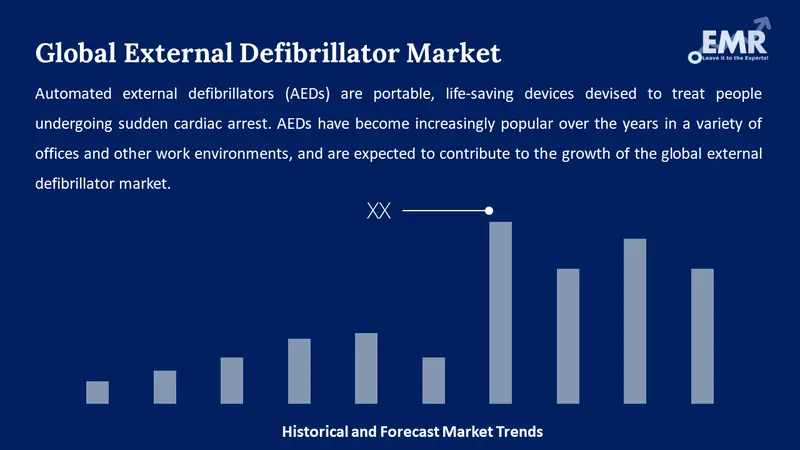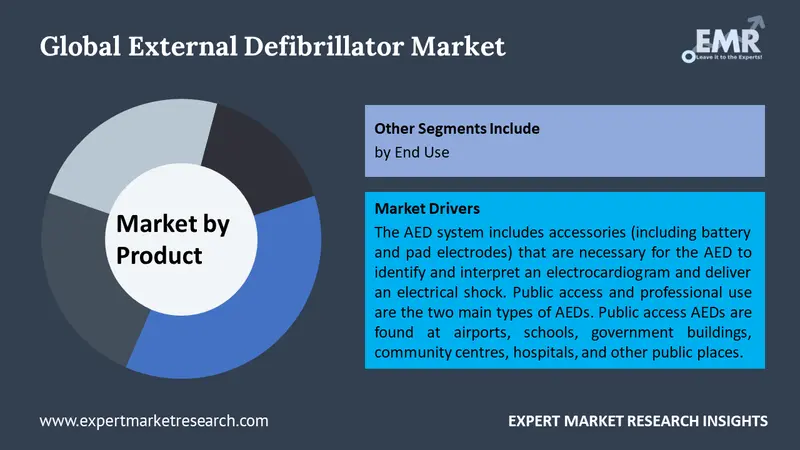
Consumer Insights
Uncover trends and behaviors shaping consumer choices today
Procurement Insights
Optimize your sourcing strategy with key market data
Industry Stats
Stay ahead with the latest trends and market analysis.
The global external defibrillator market reached a value of USD 4.18 Billion in 2025 driven by the technically Advanced Solutions and the Need to Respond to Emergencies Related to Cardiac Arrest. During the forecast period 2026-2035, the market is expected to grow at a CAGR of 8.80% to reach USD 9.72 Billion.
Base Year
Historical Period
Forecast Period
Compound Annual Growth Rate
8.8%
Value in USD Billion
2026-2035
*this image is indicative*
Ventricular fibrillation, triggered by unsystematic electrical activity in the main pumping chambers of the heart, is a common reason behind cardiac arrest. Treatment for ventricular fibrillation is defibrillation or delivery of electric shock to the heart through the individual’s chest wall. The shock seeks to stop unsystematic electrical activity and enable resumption of the heart’s normal rhythm.
Mainly, there are three types of defibrillators - Automated external-defibrillators (AEDs), implantable cardioverter-defibrillators (ICDs), and wearable cardioverter defibrillators (WCDs). WCDs have sensors that may be attached to the skin. These are attached by wires to a unit that checks the heart’s rhythm and delivers shocks when required. The WCD, like an ICD, can supply low- and high-energy shocks. The apparatus comes with a belt attached to a vest that may be worn under the clothes. The device can also send a record of the heart’s activity to doctors.
An external defibrillator and an internal defibrillator are, in essence, the same machine, and serve the same purpose; however, their use depends on two different scenarios. An internal defibrillator is indeed implanted into the patient’s body to continually monitor the heart rate and deliver automated defibrillation if the system detects a dangerous drop in the heart rate. On the other hand, an external defibrillator is intended to be an external device readily kept on hand in case of an emergency cardiac arrest.

Read more about this report - REQUEST FREE SAMPLE COPY IN PDF
Automated external defibrillators (AEDs) are portable, life-saving devices devised to treat people undergoing sudden cardiac arrest. AEDs have become increasingly popular over the years in a variety of offices and other work environments, and are expected to contribute to the growth of the global external defibrillator market. The AED system includes accessories (including battery and pad electrodes) that are necessary for the AED to identify and interpret an electrocardiogram and deliver an electrical shock. Public access and professional use are the two main types of AEDs. Public access AEDs are found at airports, schools, government buildings, community centres, hospitals, and other public places. These are meant to be used by common people with minimal training. On the other hand, professional use AEDs are intended for use by first responders, such as emergency medical technicians (EMTs) and paramedics, who have undergone additional AED training. AEDs could be semi-automated or fully automated. Semi-automated defibrillators analyse the heart's rhythm, and signal the user to deliver a defibrillation shock by pressing a button if the system detects an abnormal heart rhythm that requires a shock. Fully automated defibrillators analyse the heart's rhythm and deliver a defibrillation shock if directed by the device software; these systems do not require user intervention.
Popular AED products include HeartSine® Samaritan® PAD 350P, Philips HeartStart Onsite AED, Zoll AED Plus, Defibtech Lifeline AED, Cardiac Science Powerheart® G5 AED, and Philips HeartStart FR3 AED, among others.
External Defibrillator Market Report and Forecast 2026-2035 offers a detailed analysis of the market based on the following segments:
By product, the global external defibrillator market is divided into:
By end use, the market is classified into:
By region, the market is segmented into:

Read more about this report - REQUEST FREE SAMPLE COPY IN PDF
The report presents a detailed analysis of the following key players in the global external defibrillator market, looking into their capacity, and latest developments like capacity expansions, plant turnarounds, and mergers and acquisitions:
The EMR report gives an in-depth insight into the industry by providing a SWOT analysis as well as an analysis of Porter’s Five Forces model.




*While we strive to always give you current and accurate information, the numbers depicted on the website are indicative and may differ from the actual numbers in the main report. At Expert Market Research, we aim to bring you the latest insights and trends in the market. Using our analyses and forecasts, stakeholders can understand the market dynamics, navigate challenges, and capitalize on opportunities to make data-driven strategic decisions.*
Get in touch with us for a customized solution tailored to your unique requirements and save upto 35%!
Globally, external defibrillator market reached a value of USD 4.18 Billion in 2025.
Over the forecast period of 2026-2035, the market is projected to grow at a CAGR of 8.80% to reach USD 9.72 Billion by 2035.
The major drivers of the market include the rising focus on public access defibrillator (PAD) by public and private organisations, rise in demand for quality medical care, increase in number of training and awareness programs, and supportive initiatives by governments and healthcare organisations.
The increasing need to respond to cardiac arrest emergencies and increase in adoption of technologically advanced defibrillators devices are the key industry trends propelling the market's growth.
The major regions in the industry are North America, Latin America, the Middle East and Africa, Europe, and the Asia Pacific.
The various products in the market are wearable cardioverter defibrillators, implantable cardioverter defibrillators, manual external defibrillators, and automated external defibrillators. Automated external defibrillators are further broken down into semi-automated ED and fully automated ED.
The end-uses of the market are pre-hospital, public access market, hospital, home healthcare, and alternate care market.
The major players in the industry are Koninklijke Philips N.V., Stryker Corporation, ZOLL Medical Corporation, Nihon Kohden Corporation, and Boston Scientific Corporation, among others.
Explore our key highlights of the report and gain a concise overview of key findings, trends, and actionable insights that will empower your strategic decisions.
| REPORT FEATURES | DETAILS |
| Base Year | 2025 |
| Historical Period | 2019-2025 |
| Forecast Period | 2026-2035 |
| Scope of the Report |
Historical and Forecast Trends, Industry Drivers and Constraints, Historical and Forecast Market Analysis by Segment:
|
| Breakup by Product |
|
| Breakup by End User |
|
| Breakup by Region |
|
| Market Dynamics |
|
| Supplier Landscape |
|
| Companies Covered |
|
Datasheet
One User
USD 3,299
USD 2,969
tax inclusive*
Single User License
One User
USD 5,499
USD 4,949
tax inclusive*
Five User License
Five User
USD 6,999
USD 5,949
tax inclusive*
Corporate License
Unlimited Users
USD 8,199
USD 6,969
tax inclusive*
*Please note that the prices mentioned below are starting prices for each bundle type. Kindly contact our team for further details.*
Flash Bundle
Small Business Bundle
Growth Bundle
Enterprise Bundle
*Please note that the prices mentioned below are starting prices for each bundle type. Kindly contact our team for further details.*
Flash Bundle
Number of Reports: 3
20%
tax inclusive*
Small Business Bundle
Number of Reports: 5
25%
tax inclusive*
Growth Bundle
Number of Reports: 8
30%
tax inclusive*
Enterprise Bundle
Number of Reports: 10
35%
tax inclusive*
How To Order

Select License Type
Choose the right license for your needs and access rights.

Click on ‘Buy Now’
Add the report to your cart with one click and proceed to register.

Select Mode of Payment
Choose a payment option for a secure checkout. You will be redirected accordingly.
Gain insights to stay ahead and seize opportunities.

Get insights & trends for a competitive edge.

Track prices with detailed trend reports.

Analyse trade data for supply chain insights.

Leverage cost reports for smart savings

Enhance supply chain with partnerships.

Connect For More Information
Our expert team of analysts will offer full support and resolve any queries regarding the report, before and after the purchase.
Our expert team of analysts will offer full support and resolve any queries regarding the report, before and after the purchase.
We employ meticulous research methods, blending advanced analytics and expert insights to deliver accurate, actionable industry intelligence, staying ahead of competitors.
Our skilled analysts offer unparalleled competitive advantage with detailed insights on current and emerging markets, ensuring your strategic edge.
We offer an in-depth yet simplified presentation of industry insights and analysis to meet your specific requirements effectively.
Share